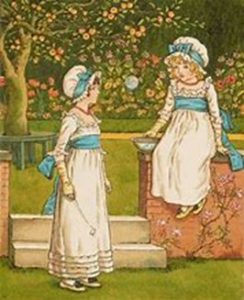Last month, I wrote about Randolph Caldecott, the children’s picture book artist, born in Chester in northwest England in 1846.
Caldecott admired a fellow artist called Kate Greenaway, who was born in London in the same year as Randolph Caldecott.  When Kate Greenaway was quite young her parents movd the family to Nottinghamshire for a few years. Kate really liked this part of the English countryside, and we see this love of the countryside in her work. Kate was mostly taught at home until the age of twelve when she started night school for art lessons. At age thirteen she went into full-time art training. While she was still studying she was able to earn money from her work and this developed as her style and confidence improved.
When Kate Greenaway was quite young her parents movd the family to Nottinghamshire for a few years. Kate really liked this part of the English countryside, and we see this love of the countryside in her work. Kate was mostly taught at home until the age of twelve when she started night school for art lessons. At age thirteen she went into full-time art training. While she was still studying she was able to earn money from her work and this developed as her style and confidence improved.
 One interesting thing about Kate Greenaway’s art is that her paintings and illustrations famously have children dressed in Regency clothes. She was so influential that a full generation of mothers in the 1880s and 1890s dressed their children in Kate Greenaway Regency style (1811 – 1820).
One interesting thing about Kate Greenaway’s art is that her paintings and illustrations famously have children dressed in Regency clothes. She was so influential that a full generation of mothers in the 1880s and 1890s dressed their children in Kate Greenaway Regency style (1811 – 1820).

Like Caldecott, Kate Greenaway inspired a literary award, but in the UK, rather than USA. The award is called the Kate Greenaway Medal and it is awarded annually to an illustrator for ‘distinguished illustration in a book for children’. The book must be first published in the UK during the preceding school year and must have English language text.
The Medal is awarded by the Chartered Institute of Library and Information Professionals, and the winner receives a golden medal, £500 worth of books to donate to a library of their choice, and the £5000 Colin Mears Award. Colin Mears was an accountant and children’s book collector who left a bequest to The Library Association providing every KGM winner with a cash award as well as the coveted Medal.
The first Kate Greenaway Medal was awarded to Edward Ardizzone in 1956, for his lovely book, Tim All Alone. A few other famous Medal winners are Shirley Hughes, Helen Oxenbury, Barbara Firth, Michael Foreman, Charles Keeping, Quentin Blake, Raymond Briggs, Janet Ahlberg, and John Burningham. You might recognise some of those names from your own childhood or from reading picture books to children over the past however many years.
A couple of my favourites are Alan Lee’s illustrations of Rosemary Sutcliff’s Black Ships Before Troy,
 and J P Lynch’s The Christmas Miracle of Jonathan Toomey.
and J P Lynch’s The Christmas Miracle of Jonathan Toomey.

Next month I’ll look at children’s chapter books that have won awards. Books that are good literature for children, books that might even persuade children to come away from a screen for half an hour. In the meantime, I hope you have time to enjoy these award-winning books and enrich your reading time with your children.
